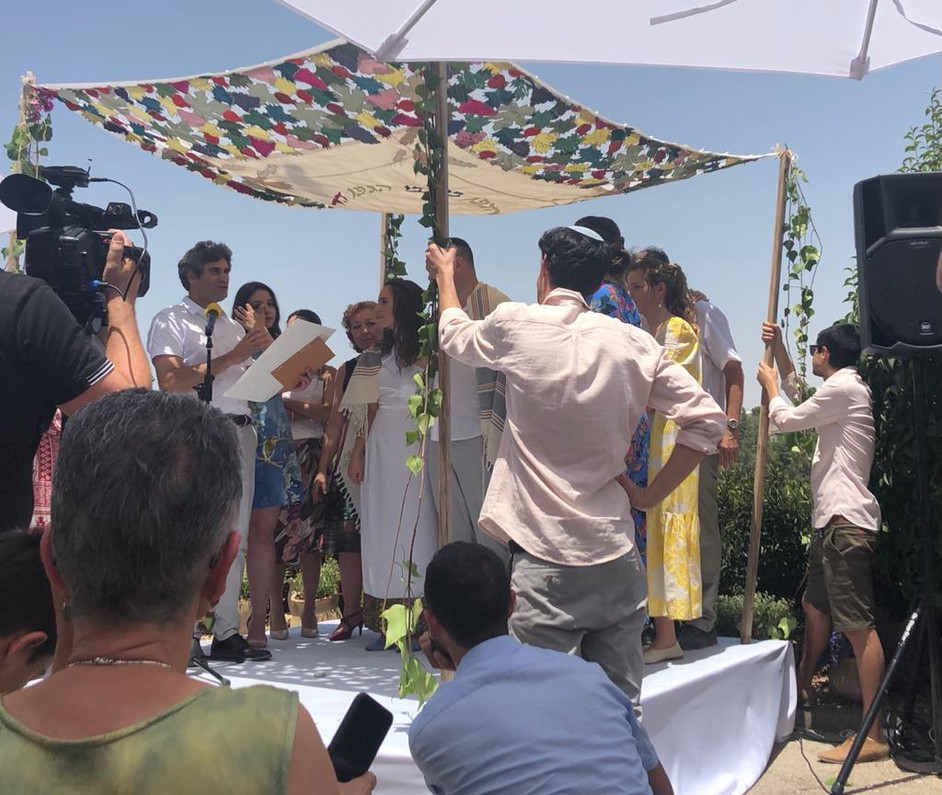13 Jewish Wedding Traditions and Customs
Jewish Wedding Traditions

Selecting a day and date for a wedding is often a challenge. Tuesdays are often selected, It says twice in Genesis about the third day of creating the world, "And God saw that it was good" (Genesis 1:10 and 12), The end of year around Hanuka is regarded as a good times for wedding as around the month of Adar, and Lag Be Omer, and the 15th of Av – the Jewish Valentines day.
Jewish weddings are often held in a Synagogue outside of Israel. While in Israel they are usually held in the open air under a wedding.
1. Aufruf: The Aufruf is a Yiddish for “to call up”. On the shabat prior to the wedding the bride and groom are called to the Torah for a blessing. The Rabbi’s blessing is called a ‘misheberach’ then members of the community throw candies on the couple.
2. The Walk to the Chuppah or down the Aisle: In Jewish tradition both the grooms parents walk the groom down the aisle to the Chuppah. Then the bride and her parents follow. Sometimes the brides parents stop half way and wait and the groom comes forward and puts onher veil and they walk down the aisle together. After the brides parents have already walked to the chuppah
3.Fasting:The wedding
day is considered a day of forgiveness,
as if to say the new life of marriage is a clean slate, so, some couples choose
to fast the day of their wedding, just as they would on Yom Kippur (the Day of
Atonement). The couple's fast will last until their first meal together after
the wedding ceremony.
4. The Chuppah: The Chuppah is the wedding canopy. It is usually a decorative cloth or talit supported by four poles, which may either stand on their own or be held by wedding party members or honored guests. The chuppah represents the creation of a Jewish home and a show of hospitality to the assembled guests. During a Jewish wedding ceremony, the Rabbi who conducts the ceremony and parents of the couple stand with the soon-to-be married couple under the chuppah together with family members.,

5. Ketubah: The signing of the Ketuba the Jewish marriage contract outlines the groom's responsibilities to his bride. It is the basis of the marriage. It spells out the conditions he will provide for in the marriage, the bride's protections and rights, and the framework should the couple choose to divorce. The ketubah is signed by the couple in front of two witnesses( not family) before the ceremony takes place. It is then is read to the guests during the ceremony. The concept of the protection of the= bride and ensuring her financial wellbeing was an innovative idea.
6. The Bedeken: During the Ketuba signing, the groom approaches the bride for the bedeken or veiling ceremony. He looks ast hjer and veils her face. It stems from the Bible when Jacob was tricked into marrying Leah the sister of the woman he loved.
7. Circling: In some more religious traditions, the bride walks in a circle around the groom seven times. There are several reasons for this, but it’s most often seen as the bride creating a “wall of protection” around the groom.
8. Giving of the Ring: In Jewish law, a marriage becomes official when the groom gives an object of value to the bride and this is traditionally done with a ring. The ring should be totally plain, without stones or marks ― just as it is hoped that the marriage will be one of simple beauty.
The couple now exchange rings and declare their betrothal vows to each other. The words, “by this ring you are consecrated to me according to the law of Moses and Israel” form the essence of the marriage service. The circle of the ring is a symbol of the eternal nature of the marriage covenant.
9. Sheva brachot: The sheva brachot are seven blessings that are recited by the rabbi during the wedding ceremony. They are recited over a cup of wine during the latter part of the proceedings. Usually family and best friends recite the blessings. It is regarded as an honour to be called on to recite a blessing.
10. Glass Breaking: At the end of the ceremony the groom breaks a glass. At which everyone sings out Mazal Tov and the music starts. The breaking of the glass represents the destruction of the Temple. Even in our happiest times we think of the temple.
12. The Ichud: After the ceremony the couple go to a private room in seclusion and spend a few minutes together before they face the festivitites. Some times a light meal is had at this time.
13. The Mezinka: When the bride or groom is the last child in their family to marry, there is a tradition to have a mezinka dance. Parents (and grandparents, if you'd like) are seated in the center of the dance floor. Their children dance around them. The parents are often given brooms to finish "sweeping their children out of their home" and to celebrate that all of their offspring are now settled into families of their own.
Recent Posts
-
Tips for Non Jews attending a Passover Seder
I’ve been invited to a seder but Im not Jewish – what do I need to know That’s awesome! Getting …8th Apr 2025 -
Making the Passover Seder fun for Kids
Passover Pesach – involving the kids: Passover is a festival really aimed at telling the story …8th Apr 2025 -
Pesach recipes from Hungary - My mothers tradition
Hungarian cuisine has a rich tradition of Pesach (Passover) recipes, influenced by Ashkenazi customs …26th Mar 2025

